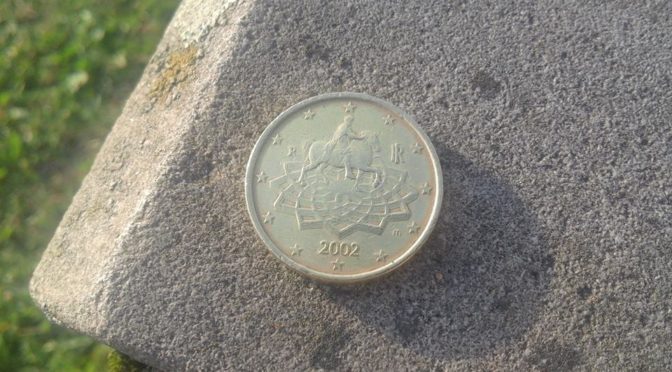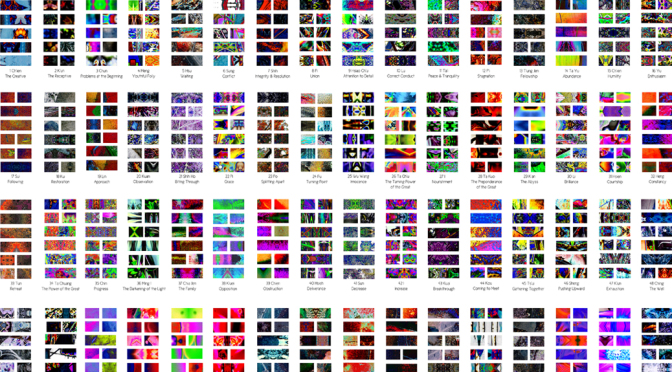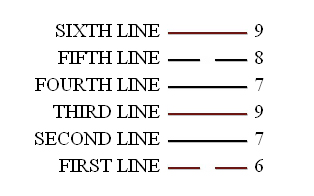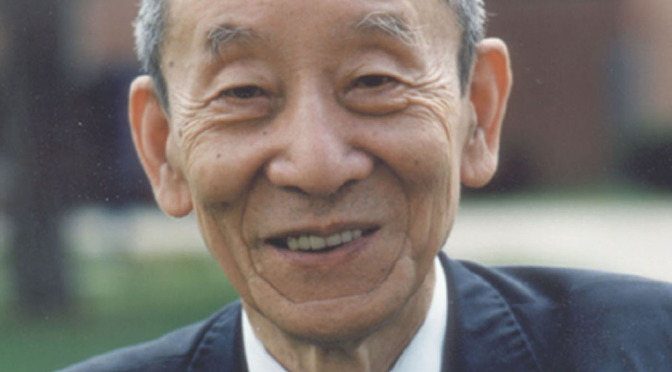Ci spiace, ma questo articolo è disponibile soltanto in Polacco.



1. Shake three coins in your closed hands and drop them.
2. Count heads as three and tails as two, and add the value of all three coins. Three heads equals nine, two heads and one tail equals eight, and so on.
3. If the number is odd, draw an unbroken line. If it is even, draw a line that is broken in the center. Write the numerical value of the line next to it.
4. Throw the coins again to get the second line of your hexagram. Draw the line above, not below, the first line.
5. Repeat this procedure until you have six stacked lines. Remember to proceed upward from the first line, not downward. Your hexagram might look like this:

6. To find out which hexagram this is, consult the chart below for reference. The bottom three lines are the lower trigram, and the top three lines are the upper trigram. The number on the chart that lies at their intersection indicates which hexagram you have thrown. The example above is number 50.
Continua a leggere
We are able to recognize the life world behind physical nature when we begin to have a moral perception of the world lying around us.
Spiritual science does not merely signify the acquisition of knowledge; it signifies most preeminently an education, a self-education of our souls. We make ourselves different; we have other interests. When one imbues oneself with spiritual science, the habits of attention for this or that subject that one had developed in previous years alter. What was once of interest is of interest no longer; what was of no interest previously now begins to be interesting in the highest degree.
I am speaking to those who have, to some extent, accepted spiritual science. Therefore I may take it for granted that you know that immediately behind what meets us externally as human beings—behind what we see with our eyes, touch with our hands, and grasp with our understanding in ordinary human anatomy or physiology, behind what we call the physical body—we recognize the first supersensible human principle. This supersensible principle of the human being we call the etheric body, or life body. […]
We can do something similar with regard to the nature around us. Just as we can investigate a human being to see whether there is not something more than the physical body and then find the etheric body, so, too, we can look at external nature in her colors, forms, sounds, and kingdoms—in the mineral, plant, animal, and human kingdoms, insofar as these meet us physically. We discover that just as behind the human physical body there is a life body, so there is a sort of etheric body, or life body, behind the whole of physical nature…
Continua a leggere

«Tra la vita filosofica e la vita pratica si deve raggiungere un grande equilibrio. Se riuscirete ad apprendere questo allora sarete effettivametne un filosofo pratico. Filosofare sulla filosofia pura non è una grande conquista. I filosofi sono spesso sognatori. È importante invece introdurre la nostra filosofia nella vita di tutti i giorni, in modo che la vita con le sue avversità e le sue gioie possa essere guidata dalla filosofia. Pur mantenendo fede alla nostra evoluzione e al nostro sviluppo, possiamo forse vivere con successo in società senza rinunciare al nostro cammino spirituale? Questa è la filosofia pratica.»
B.K.S Iyengar L’Albero dello yoga
Permaculture has been used to design buildings, energy and wastewater systems, villages, and even less tangible structures such as school curricula, businesses, community groups, and decision-making processes.
Permaculture uses a set of principles and practices to design sustainable human settlements. The word, a contraction of both “permanent culture” and “permanent agriculture,” was coined by two Australians. The first was Bill Mollison 1)↓, author of the dense and encyclopedic bible of the field, Permaculture: A Designer’s Manual. The other is David Holmgren 2)↓, who has brilliantly expanded permaculture’s scope.
Mollison says the original idea for permaculture came to him in 1959 when he was observing marsupials browsing in Tasmanian rain forests. Inspired and awed by the life-giving abundance and rich interconnectedness of this ecosystem, he jotted in his diary, “I believe that we could build systems that would function as well as this one does.” In the 1970s he and Holmgren, using what they had observed in nature and in indigenous cultures, began to identify the principles that made those systems so rich and sustainable. Their hope was to apply these principles to designing ecologically sound, productive landscapes. They reasoned that if life had been thriving on Earth for over three billion years, if indigenous peoples had been living relatively harmoniously in their environments for millennia, then life and indigenous cultures must have figured out some things about sustainability. David’s undergraduate thesis, which he and Bill revised and expanded, evolved into the groundbreaking book Permaculture One.
Continua a leggere
| 1. | ↑ | charismatic and iconoclastic one-time forester, schoolteacher, trapper, field naturalist |
| 2. | ↑ | one of the first of Bill’s many students |

…Innanzitutto quindi vediamo in che modo vivranno i cittadini così organizzati. Quale altro impegno avranno se non produrre cibo, vino, indumenti e calzature? Poi si costruiranno le case e d’estate lavoreranno seminudi e scalzi, d’inverno [372b] ben coperti e calzati. Si nutriranno ricavando farina dall’orzo e dal frumento, cuocendo e impastando, e serviranno ottime focacce e pani su una canna o su foglie pulite; e sdraiati su giacigli cosparsi di smilace 1)↓ e mirto banchetteranno essi e i loro figli bevendo vino e cantando inni agli dèi col capo cinto di corone. Vivranno insieme piacevolmente e non metteranno al mondo più figli di quanto consentano [372c] le loro sostanze, per timore della povertà e della guerra».
A quel punto prese la parola Glaucone: «A quanto sembra, tu fai pranzare questi uomini senza companatico!».
«È vero», dissi. «Mi sono dimenticato che avranno anche il companatico, cioè sale, olive, formaggio, e cuoceranno bulbi e verdure, come si suole fare in campagna. Imbandiremo loro anche pasticci di fichi, ceci e fave, e arrostiranno al fuoco, [372d] sotto la cenere, bacche di mirto e ghiande, bevendo moderatamente; così passeranno la vita in pace e in buona salute, com’è naturale, moriranno vecchi e trasmetteranno un analogo modo di vivere ai loro discendenti».
Ed egli replicò: «Socrate, se fondassi una città di porci, li pasceresti con un cibo diverso da questo?»
Continua a leggere
| 1. | ↑ | Pianta simile all’edera. |


Rooted in the traditional teachings of East and West, the term macrobiotics derives from the Greek root words macro, meaning “long” or “great” and bios, meaning “life.” It was coined by Hippocrates, the father of medicine, nearly 2,500 years ago, whose approach to health and healing was based on his famous proverb “Let food be thy medicine, and thy medicine be food.”
Macrobiotic-quality foods are organically grown as much as possible, traditionally or naturally processed, and contain no sugar, dairy, white flour, chemicals, or other harmful ingredients.
The macrobiotic way of eating is very broad and comprehensive. It has been observed by millions of human beings for thousands of years, contributing to health, happiness, and peace for endless generations and our species’ overall biological and spiritual evolution. For the most part, it is based on whole cereal grains (the traditional staff of life), vegetables from land and sea, beans, and other fresh foods, with a minimum of animal products. With the advent of the modern era about 400 years ago, this way of eating steadily declined around the world, as meat, poultry, eggs, and dairy became the center of the diet; white flour and white rice displaced whole-wheat flour and brown rice; and canned and frozen foods, highly processed foods, and foods grown with or containing chemicals largely replaced fresh, local produce grown organically and consumed in season.
The goal of macrobiotics is freedom—the ability to create and realize our dream in life as part of our endless spiritual journal in the infinite universe.
The macrobiotic approach is based not only on meeting optimal nutritional needs but also on a deep understanding of the earth’s relation to the sun, moon, and other celestial bodies; the evolution of life on the planet; ancestral tradition and heritage; ever-changing environmental and climatic conditions; humidity, pressure, and other atmospheric influences; local availability, affordability, and other economic factors; natural storability and other practical considerations; and the effects of different foods and beverages on our mind, body, and spirit. The macrobiotic way of eating is not a set diet that applies rigidly to everyone, but a flexible dietary approach that differs according to climate, environment, condition of health, sex, age, activity level, and personal need. Macrobiotics is the collective wisdom and universal heritage of humanity.
Continua a leggere
